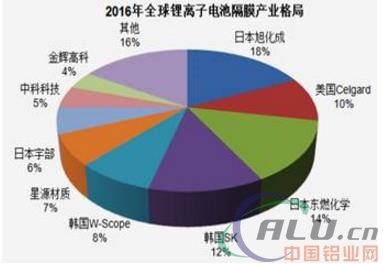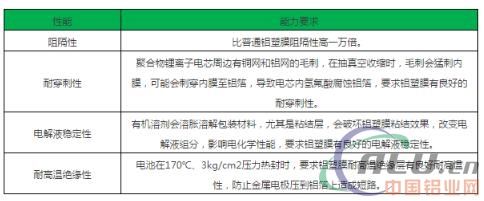[China Aluminum Network] As a lithium-ion battery producer and consumer, China has basically formed a complete industrial chain from mineral resources, battery materials and accessories to lithium-ion batteries and end-use applications. In recent years, China’s lithium-ion battery market has maintained a rapid growth form. The lithium-ion battery market in China has grown from RMB 27.7 billion in 2011 to RMB 85 billion in 2015, with an average CAGR of 32.4%. The following describes the lithium-ion battery separator and aluminum plastic film technology. Diaphragm 1 The role of lithium ion battery separator The separator is an important part of the lithium-ion battery. It is located between the positive and negative electrodes in the battery to ensure that lithium ions pass through and hinder the electron transport. The performance of the separator determines the interface structure and internal resistance of the battery, directly affects the capacity, cycle, and safety performance of the battery. The separator with excellent performance plays an important role in improving the overall performance of the battery. 2 Lithium-ion battery requirements for the diaphragm Lithium-ion battery requirements for the diaphragm include: (1) Has electrical insulation to ensure positive and negative mechanical isolation; (2) Have a certain pore size and porosity, ensure low resistance and high ionic conductivity, have good permeability to lithium ions; (3) resist electrolyte corrosion, have sufficient chemical and electrochemical stability This is because the electrolyte solvent is a highly polar organic compound; (4) It has good electrolyte wettability and strong ability to absorb moisture; (5) high mechanical stability, including puncture strength, tensile strength, etc., but the thickness is as small as possible; (6) Space stability and good integrity; (7) Thermal stability and automatic shutdown protection performance; (8) Small heat shrinkage, otherwise it will cause a short circuit, causing the battery to lose thermal control. In addition, power batteries generally use composite membranes, which require more diaphragms. 3 Lithium-ion battery separator classification According to the differences in physical and chemical properties, lithium battery separator can be divided into: weaving film, non-woven film (non-woven fabric), microporous film, composite film, separator paper, laminated film and so on. Although there are various types, commercially available lithium battery separator materials mainly use polyethylene and polypropylene microporous membranes. 4 Lithium-ion battery separator process At present, there are mainly wet and dry methods for preparing lithium ion battery separators. Wet method, also known as phase separation or thermal phase separation, mixes liquid hydrocarbons or small molecules with a polyolefin resin, heats and fuses to form a homogeneous mixture, then cools down to separate the phases, compress the membrane, and then apply the membrane. The sheet is heated to a temperature close to the melting point, the biaxial stretching is performed to align the molecular chains, and the subsequent incubation is performed for a certain period of time. The residual solvent is eluted with a volatile substance to prepare a microporous membrane that is interpenetrating. In the dry method, a polyolefin resin is melted, extruded, and blown to form a crystalline polymer film. After crystallization treatment and annealing, a highly oriented multilayer structure is obtained. Further stretching is performed at a high temperature to strip the crystal face. The formation of a porous structure can increase the pore size of the film. Wet and dry methods have their own advantages and disadvantages. Among them, the wet process film has a small and uniform pore size, and the film is thinner. However, the investment is large, the process is complicated, and the environmental pollution is large. The dry process is relatively simple, the added value is high, and the environment is friendly. However, it is difficult to control the pore size and porosity, and it is difficult for products to be thin. 5 two kinds of lithium ion battery separator technology core technology For the wet process, the extrusion mixing process of the resin and the additive and the stretching process are the two core issues of the process. The extrusion process requires good mixing of materials, strong plasticizing ability, and stable extrusion process. The stretching process determines the orientation of the molecular chains and the uniformity of the pore-forming agent distribution. For the dry process, in addition to the extrusion mixing process, the melt draw ratio and the heat treatment are all core processes. At present, the manufacturers of diaphragms in the world are mainly based on wet methods, and the price of wet diaphragms is relatively expensive. In the future, wet diaphragms will still take the high-end market route in power batteries, while the low-end power batteries will still be dominated by dry methods. . 6 Global Lithium Ion Battery Separator The market demand for lithium-ion battery separators worldwide is increasing year by year. Membrane shipments have increased from 240 million square meters in 2009 to 1.185 billion square meters in 2014. Asahi Kasei of Japan, Dongbu Chemical of Japan and Celgard of the United States (Celgard was acquired by Asahi Kasei Corporation on behalf of wet technology in February 2015, production of dry process lines and the establishment of a new wet process line) are the Big Three of the diaphragm, occupying a global market share of as high as 77 %. However, with the rise of South Korean and Chinese companies, the share of the Big Three is rapidly declining, accounting for about 56% in 2014. 7 Chinese lithium ion battery diaphragm gap Lithium battery separator is the higher technical barrier in the four major materials, its cost accounting for only the cathode material, about 10% - 14%, in some high-end batteries, the diaphragm cost accounted for even 20%. China's lithium ion battery separator has made major breakthroughs in the dry process, and now it has a world-class manufacturing level. However, in the field of wet diaphragms, domestic diaphragm companies are limited by many factors such as process and technology, and their product levels are still relatively low. Production equipment mainly depends on imports. China's diaphragm products have a large gap with foreign products in terms of consistency in thickness, strength, and porosity, and product lot consistency needs to be improved. Plastic film 1 The role of lithium-ion battery aluminum plastic film Aluminum plastic film is one of the five materials for lithium ion batteries, and is a soft lithium battery packaging material. The aluminum plastic film consists of an outer nylon layer/adhesive/intermediate aluminum foil/adhesive/inner heat-sealing layer consisting of a total of five layers, each with a relatively high functional requirement. The typical aluminum film structure is shown in the figure below: 2Lithium-ion battery requirements for aluminum plastic film The barrier capability, puncture resistance, electrolyte stability, high temperature resistance, and insulation of aluminum plastic film affect the performance of lithium ion batteries. Loss of any one aspect may lead to a drop in battery performance and direct discard. Aluminum plastic film is produced using precision coating technology. At present, Japanese companies have more advanced precision coating technologies in the world. 3 lithium-ion battery aluminum plastic film process Dry process and thermal process are the main production processes for aluminum plastic film. The dry process is the direct bonding of aluminum and polypropylene after bonding with an adhesive. The thermal process is the use of MPP between aluminum and polypropylene followed by a slow temperature-increasing step-up hot press. The dry-processed aluminum-plastic film is thin, has a good appearance, has excellent deep-drawing performance and short-circuit prevention performance, and is simple in process and low in cost. However, compared with the thermal method, the electrolyte and water resistance are poor; the advantages of the thermal method In the electrolyte and water resistance is good, but the deep-drawing performance, short-circuit resistance is not as dry, poor appearance and cutting. 4 global lithium-ion battery aluminum plastic film enterprises The aluminum plastic film plays a key role in the soft lithium battery, which generally accounts for about 15-20% of the cost of the battery core. However, due to the lack of technology in China, the market share of aluminum-plastic film is very small, accounting for less than 5%. At present, 90% of the domestic aluminum plastic film market is monopolized by Japanese manufacturers, mainly DNP (Dainippon Printing), Showa Denko and T&T. As a lithium-ion material that has not yet been domesticated, aluminum-plastic film has a gross margin of 60-80%. It is estimated that the current global market space for aluminum plastic film is only several billion yuan. With the downstream demand, the industry growth rate is expected to exceed 40%, and the potential market size will reach 10 billion. 5 Lithium-ion battery aluminum-plastic film gap in China As the core material of soft pack battery, the production technology of aluminum plastic film is far more difficult than diaphragm, positive electrode, negative electrode, and electrolyte. It is one of the three high technologies in the lithium battery industry. From the aspect of product performance, there is a big gap between China's aluminum-plastic film products and foreign products, mainly reflected in: aluminum foil surface treatment process is backward and pollution is large; water treatment of aluminum foil will produce "hydrogen embrittlement", resulting in aluminum-plastic film resistance Poor; aluminum foil surface stiffness is not enough, good product rate is poor; polypropylene and aluminum foil with high thermal conductivity when the surface is easy to curl, resulting in layered crystal; domestic adhesive formulation process is poor, prone to delamination peeling problem. Due to the deficiencies of these production techniques, the punching depth of aluminum-plastic film produced in China is about 5mm, and it has not been able to achieve good performance requirements. While abroad can reach 8mm, and some even reach 12mm, there is still a certain gap between the overall and foreign products; in terms of thickness, the domestic thin aluminum film can only be 70μm, mass production of 112, 88 and 72μm, while the Japanese aluminum The thin film can be 40μm, and the mass production of 65 and 48μm is also realized. Why is it difficult to make breakthroughs in the manufacturing technology of aluminum-plastic films? Overall, there are deficiencies in materials, equipment, and processes. The technical difficulty lies mainly in the control of process-accurate control of reaction conditions.
A Euro Fence, also known as a Euro-style fence or panel fence, is a type of fencing system commonly used for residential, commercial, and industrial purposes. It is characterized by its modular design, which consists of pre-fabricated panels that are connected together to form a continuous fence.
The panels are typically made of steel or aluminum and feature a grid-like pattern of horizontal and vertical wires. The wires are welded or interlocked at the intersections to provide strength and stability to the fence. The size and spacing of the wires can vary depending on the desired level of security and aesthetic appeal.
Euro fences are known for their durability and low maintenance requirements. They are resistant to rust, corrosion, and weathering, making them suitable for outdoor use. The panels can be powder-coated or galvanized to enhance their longevity and appearance.
One of the main advantages of Euro fences is their ease of installation. The panels can be quickly and easily attached to posts or other support structures, reducing the time and labor required for installation. They can also be easily adjusted or replaced if needed.
Euro fences are commonly used for perimeter security, privacy, and decorative purposes. They can be found in residential properties, schools, parks, sports facilities, industrial sites, and other areas where security and aesthetics are important.
Overall, Euro fences offer a versatile and cost-effective solution for various fencing needs. They provide a combination of strength, durability, and aesthetic appeal, making them a popular choice for many applications.
Euro Fence,Garden Euro Fence,Garden Fencing,Welded Wire Mesh Fencing Anping Xinlong Wire Mesh Manufacture Co.,Ltd. , https://www.xinlongfence.com





